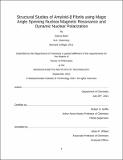| dc.description.abstract | Magic Angle Spinning Nuclear Magnetic Resonance (MAS NMR) is a powerful method that probes the structure and dynamics of insoluble molecules at atomic level detail. The last two decades has seen a rise in studies of amyloid fibrils, which have been implicated in many diseases. In particular, amyloid-β is a consistent feature in Alzheimer’s disease, with over 6 million patients in the US diagnosed to date. The first part of this thesis details the pathway to solving the structure of Aβ1-40 fibrils that were grown from pure peptide as a baseline for further studies, including brain seeding and mutations. This work was carried out in a 3.2mm rotor and spinning at a maximum of ωr/2π = 20kHz. We were able to unambiguously assign ~75% of the 40-residue peptide, and used this information to acquire long-range constraints for structure calculations. Using the CYANA software package, we have converged on a structure that satisfies the defined constraints with no violations, in which the core ranges from Q15-V40 with a backbone RMSD of 0.6 ± 0.1 Å. We proceeded to explore state-of-the-art MAS NMR methods in ultra-fast spinning ¹H-detection (ωr/2π = 111kHz) and fast-spinning high field DNP on fully protonated M₀-Aβ₁₋₄₂ fibrils, whose structure has been thoroughly characterized in in the literature. In doing so, we were able to assign ~92% of all protons in the fibril core (K16- A42), and obtained long-range ¹H¹H correlations that correspond to the fibril structure. At the same time, high field DNP experiments at ωr/2π = 40kHz produced well-resolved spectra, showing that these state of the art techniques are amenable to studies on amyloid fibrils. Finally, we set out to develop machining methods in order to fabricate diamond rotors for the purpose of combining ¹H-detection and DNP to facilitate rapid data acquisition and analysis. Our progress shows that we are able to fabricate 0.7mm rotors out of diamond that can currently spin up to ~7 kHz MAS, which will likely increase by improving the taper and concentricity of our current through-holes. Progress in this area will facilitate carrying out studies on natural abundance samples. | |
